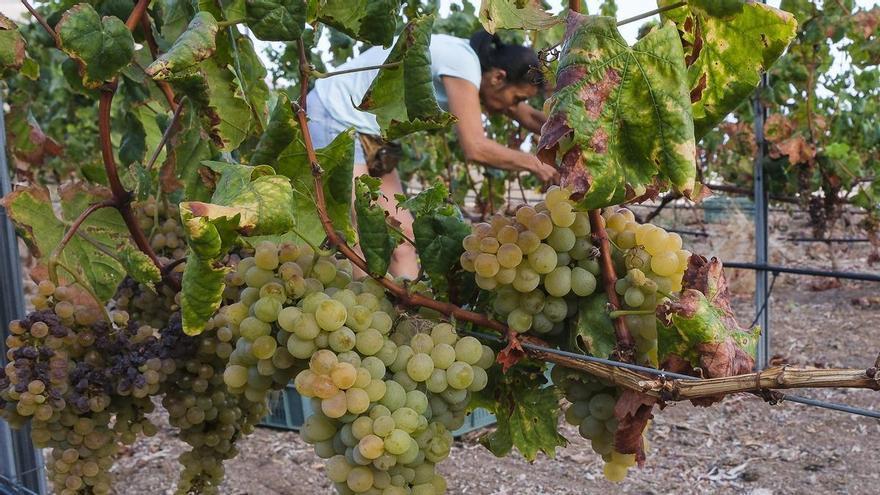
Drought and pest issues affecting the 2024 harvest in the Canary Islands have left winemakers apprehensive about the potential loss of local, national, and especially international markets. In 2023, according to the Ministry of Agriculture, Livestock, Fishing, and Food Sovereignty of the Canarian Government, 3,147 hectolitres –equivalent to 314,700 litres– of Canarian wine were exported to countries beyond Spanish territory, with 1,036 hectolitres of that total going to the United States. While definitive figures for the 2024 campaign are yet unavailable, preliminary data from the Ministry of Commerce, responsible for the end-of-year analysis, indicates a decline of about 23%, consistent with the 20% decrease observed nationally across the sector. This translates to a reduction in Canarian wine exports amounting to roughly 724 hectolitres.
Tenerife, the island with the highest concentration of vineyards, spanning over 8,000 hectares, concluded the 2024 harvest with 4.1 million kilos of grapes collected—significantly less than the over five million harvested in 2023. The Wines Regulatory Council of Tenerife reported a decrease across all five source denominations. The most impacted was the Tacoronte-Icente, which includes eight northern municipalities of the island, dropping from 1.28 million kilos in 2023 to 778,000 kilos in 2024, a 42% reduction. One of the wineries under this council, Bodegas Marba, received 25 international awards last year. Its technical director and founder, Domingo Martín, stated they have suffered a 50% loss in grape harvest, despite managing to obtain 50,000 litres. He lamented, “The drought, the lack of generational relief, and the rising costs of transportation and production are detrimental to our growth.” In fact, this winemaker plans to dispatch nine bottles of wine for a global competition in Brussels this week, and the transportation costs alone amount to 370 euros. “It’s something you really think about,” he remarked.
Martín fears jeopardising both the market and international promotion efforts that have taken considerable resources and labour to establish. The owner of Bodegas el Tis in Lanzarote, Fermín Otamendi, shares these concerns and elaborates that this potential loss makes him “genuinely worried.” He mentions, “The foreign market is extremely challenging to secure and very easy to lose,” he adds.
Lanzarote is the second-largest producer of vineyards among the Canary Islands. Data from the Insular Regulatory Council reveals that last year, winemakers gathered 1.3 million kilos as opposed to 3.3 million in 2023, resulting in over half of the harvest lost. This can be attributed to irregular sprouting and a severe water crisis affecting the island. Nevertheless, the unique conditions of The Gerias, where vines are cultivated, have allowed for maintenance of quality. Bodegas El Tis is celebrating its 250th anniversary. Despite the pride of being one of the oldest wineries in Spain, the current situation is far from ideal. In 2024, their yield was 60% lower than in 2023, and Otamendi anticipates that in 2025, “we’re expecting an even worse harvest.”
This winery exports to France, Germany, Italy, Switzerland, Holland, and Mexico, along with “some batches” to the United States and Canada. Otamendi noted their attempts to penetrate the Japanese market, but acknowledged, “they are sensitive markets” that entail “tremendous risk” without stable production guarantees. “On the islands, people understand the situation,” according to Otamendi; however, he emphasized that in those other markets, which have required “years of dedicated effort,” they do not heed reasons.
In Gran Canaria, the circumstances are even more dire, with 2024 setting a record as the worst year in the last decade. In total, 196,690 kilos collected across 110,290 hectares falls short of the 364,876 kilos of 2023 and 457,739 kilos of 2022. While to a lesser extent, this also contrasts sharply with the 274,016 kilos gathered in 2021, which until now were the lowest recorded figures. Again, the drastic drop-off is attributed, according to the Gran Canaria Regulatory Council, to unfavourable weather that distorted the vegetative cycle of the vines. This was equally the case in La Palma, where the island’s cultivation area faced a similar situation; although concrete vintage data for 2024 are not yet available, during the current grape gathering season, the amount stood at 265,600 kilos, as opposed to the total 756,000 kilos of 2023.
In El Hierro, the challenges are compounded by a lack of rainfall coupled with the emergence of pests. The Adra Mirador Winery located in La Frontera was fortunate, according to manager Andrés Acosta, to “provide irrigation to support the vineyards.” However, he cites wasps, bees, and partridges as the primary culprits behind their decreased production, which has decreased by between 40% and 50% compared to last year. He believes public authorities “have not addressed the issue adequately.
Lastly, the islands of La Gomera and Fuerteventura produce the least wine. In 2023, La Gomera had 168.9 hectares with a yield of 136,000 kilos, while Fuerteventura yielded 102,000 kilos from 27.6 hectares.
Canarian wines have secured a foothold in international markets, bolstered by their presence at major global fairs. This Monday, Barcelona is hosting one of the most significant events nationally, the Barcelona Wine Week (BWW), where wines from the islands have been selected from among the winners at Agrocanarias, a preeminent regional competition, as well as the Extreme Wine World Cup.
Subscribe to continue reading
















